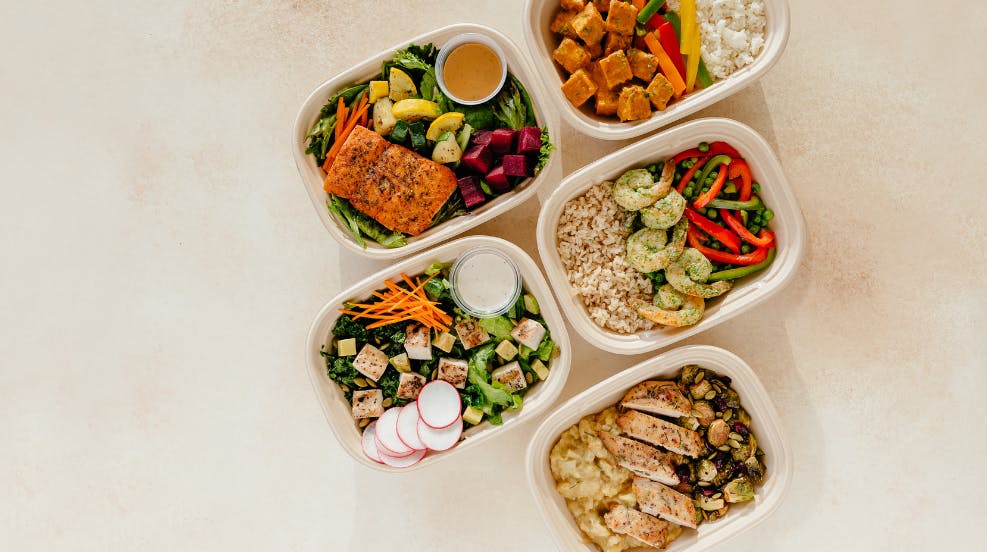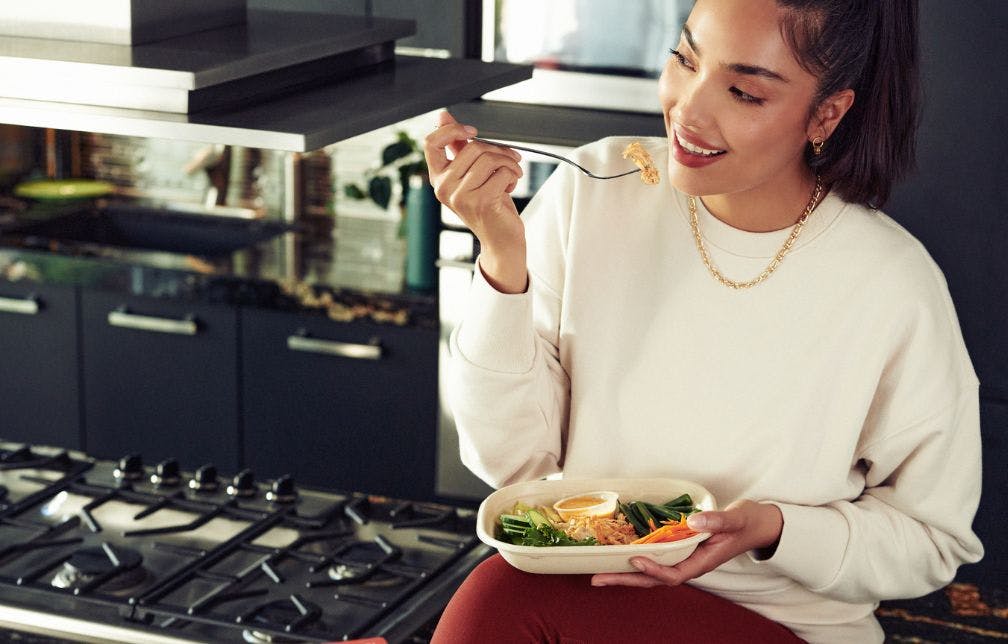
Naturally Gluten Free Foods
By Danielle McAvoy
March 31, 2021
Stepping into a gluten-free diet can often feel like you're leaving behind the familiar territory of traditional food and eating. But let's take a different perspective: instead, it can be about discovering a host of foods that are both naturally gluten-free and equally, if not more, nutritious.
As we examine the options available, you'll see that a gluten-free diet is less about limitation and more about exploration and balance. So, whether you're avoiding gluten for health reasons or personal choice, let's explore a diet that's as nutritious as it is diverse.
What Is Gluten?
Gluten is like the glue of the food protein world; it's what gives bread its chewy texture and helps pizza dough stretch without tearing. Scientifically, gluten is a group of proteins found primarily in wheat, barley, and rye. When these grains are mixed with water, the gluten proteins create a sticky network that's elastic and can trap air — hence, the rise of your favourite loaf.
Now, while gluten is a staple in many diets, a significant number of foods are naturally gluten-free. These include fruits, vegetables, meat, poultry, fish, dairy, and gluten-free grains such as rice, quinoa, and corn.
However, here's the catch: even though these foods don't naturally contain gluten, they can still be a concern. Why? Because of cross-contact. If foods are grown, harvested, processed, or prepared alongside gluten-containing foods, they can pick up traces of gluten. It's like glitter at a kid’s party; even if you don't use it directly, you’ll likely find it sticking to you.
This is particularly true for oats. Pure oats are gluten-free, but they are often processed in facilities that handle wheat, barley, or rye, leading to cross-contamination. The same goes for products like soy sauce and salad dressings, where gluten-containing ingredients might be added, and they don't always make it obvious on the label.
The conversation around trace gluten is particularly vital for individuals with celiac disease, where even minuscule amounts of gluten can trigger an autoimmune response. According to a study in the American Journal of Clinical Nutrition, even 50 milligrams of gluten — about the amount in one small crouton — can be enough to cause trouble.
For those on a gluten-free diet, it's essential to look for labels like "certified gluten-free," which means the product has been tested and contains less than 20 parts per million of gluten, a threshold that is generally considered safe for people with celiac disease.
So, while the world of naturally gluten-free foods is large and diverse, vigilance is key. It's always best to read labels, ask questions, and stay informed about where your food comes from and how it's processed.
What Foods Are Naturally Gluten-Free?
So, what foods can you enjoy with abandon on this dietary path? The answer is many, and they're all around us in their naturally occurring, unprocessed forms. This section will spotlight the naturally gluten-free foods that can form the cornerstone of a nutritious and delicious gluten-free diet.
Gluten-Free Whole Grains, Legumes and Seeds
When we think of gluten-free eating, whole grains might not come to mind immediately — but they should. Many whole grains are naturally gluten-free and full of nutrients. Quinoa, for instance, isn't just a trendy superfood; it's a complete protein and packed with fiber. Brown rice, buckwheat, and millet are also safe havens for those avoiding gluten. They offer versatility in the kitchen, from morning porridge to a hearty addition to salads.
Whole Grains, Legumes and Seeds That May Contain Gluten
However, watch out for grains like spelt, farro, and barley, which do contain gluten. For legumes and seeds, the raw forms are naturally gluten-free, but cross-contamination can occur during processing. According to a study published in the British Journal for Nutrition, oats, for instance, often contain gluten from such cross-contact, and are often the most contaminated food.
Gluten-Free Vegetables and Fruits
Vegetables and fruits are a cornerstone of any healthy diet and are naturally free of gluten. Whether you're snacking on an apple or tossing a kale salad, these are safe picks. They're rich in essential vitamins, minerals, and fibers, and are as versatile as they are nutritious.
Vegetables and Fruits That May Contain Gluten
Yet, when we venture into the realm of canned, frozen, or pre-chopped options, caution is required. Additives or preservatives in processed vegetables and fruits could contain gluten, and even cross-contamination in the packaging process is possible.
Gluten-Free Proteins
Proteins like fresh meats, poultry, fish, and eggs are naturally free of gluten. They're fundamental to maintaining a balanced diet and can be prepared in countless gluten-free ways.
Proteins That May Contain Gluten
However, processed proteins are another story. Deli meats, meat substitutes, and prepared entrees often have gluten-containing additives.
Gluten-Free Dairy Products
Most dairy products, such as milk, butter, ghee, and most cheeses, are naturally gluten-free and provide a good source of calcium and vitamin D.
Dairy Products That May Contain Gluten
Yet, flavored dairy products, like certain yogurts and ice creams, may be deceptive harbors of gluten due to flavorings or additives. According to the Celiac Disease Foundation, it's always crucial to check labels for gluten-containing ingredients.
Gluten-Free Fats and Oils
Pure fats and oils, including olive oil, coconut oil, and avocado oil, are naturally gluten-free and, when used in moderation, can be a healthy part of a balanced diet.
Fats and Oils That May Contain Gluten
Beware of cooking sprays and flavored oils, which might contain gluten as a flavoring agent.
Gluten-Free Sauces, Spices, and Condiments
Spices and fresh herbs in their pure, raw form are gluten-free and are your best allies in the kitchen to add flavor without adding gluten.
Sauces, Spices, and Condiments That May Contain Gluten
Yet, common culprits like soy sauce, salad dressings, and some marinades often contain gluten.
Gluten-Free Desserts and Sweets
For the sweet tooth, there are many gluten-free dessert options, from meringues and macarons made with almond flour to gluten-free cakes and cookies.
Desserts and Sweets That May Contain Gluten
However, desserts and sweets are often gluten minefields. Many baked goods, candies, and even some chocolate can contain gluten, either as an ingredient or through cross-contamination. Reading labels and seeking out certified gluten-free products is key.
If you're living that gluten-free life, you've got a whole world of tasty foods to look forward to. The trick? Stay sharp and clued in. Got a sneaky suspicion about something? Flip that package over and give the label a once-over.
Elevate Your Eating: Discover Gluten-Free Excellence with Territory Foods
A gluten-free diet can be rich with possibilities and filled with diverse and delicious options that cater to your health and palate. However, navigating the gluten-free landscape can sometimes be challenging, especially when it comes to preparing meals that are both safe and satisfying.
That’s where we at Territory Foods can step in. Our gluten-free meal delivery service is designed to take the guesswork out of eating well. With a wide range of chef-crafted, nutritionist-approved meals, you can enjoy the peace of mind that comes with knowing every dish is not only safe for your gluten-free diet but also delicious and nutritious.
Get started today with Territory Foods and relish the convenience of wholesome, gluten-free meals delivered straight to your home. Simply visit Territory Foods to embark on a hassle-free, gluten-free culinary adventure.
Your journey to healthful, satisfying dining begins with just a click!
Gluten Free FAQs

Let's tackle some of the most common queries to clear up any confusion and provide clear-cut answers to some frequent gluten-free food questions.
Is Rice Gluten-Free?
Yes, rice in all its natural forms — be it white, brown, or wild — is gluten-free. It's a versatile grain for those following a gluten-free diet.
Is Oatmeal Gluten-Free?
While oats are naturally gluten-free, the concern is with processing. Oats often share processing facilities with wheat, which can lead to cross-contamination. Always opt for oats that are certified gluten-free.
Is Quinoa Gluten-Free?
Absolutely, quinoa is gluten-free. This seed, often used like a grain, is also a protein powerhouse and a great alternative to wheat-based grains.
Are Oats Gluten-Free?
Like oatmeal, oats themselves are gluten-free. However, to avoid the risk of gluten contamination, seek out brands that guarantee their oats are processed in a gluten-free environment.
Are Potatoes Gluten-Free?
Potatoes are a gluten-free food. They're nutritious and can be prepared in countless ways. However, it's important to watch out for added ingredients in pre-packaged potato products, which may contain gluten.
Are Doritos Gluten-Free?
Most varieties of Doritos are not gluten-free as they contain wheat flour. Some flavors are labeled gluten-free, so always check the packaging for confirmation.
Are Rice Krispies Gluten-Free?
Traditional Rice Krispies are not gluten-free since they contain malt flavoring from barley. Look for gluten-free labeled alternatives that are safe for a gluten-free diet.
Is Sourdough Bread Gluten-Free?
Standard sourdough bread is made from wheat and is not gluten-free. There are gluten-free sourdough bread options made with gluten-free flour mixes.
Are Corn Tortillas Gluten-Free?
Corn tortillas are typically gluten-free as they're made from masa harina, a dough from ground maize. You should, however, confirm that they haven't been produced in a facility that also processes wheat flour.
Is Cornstarch Gluten-Free?
Cornstarch is gluten-free and can be used as a thickener in various gluten-free recipes.
Is Popcorn Gluten-Free?
Popcorn is a naturally gluten-free snack. Just be cautious of any added flavors or coatings that could contain gluten.
Are Grits Gluten-Free?
Grits, made from dried maize kernels known as hominy, are naturally gluten-free. But as with all naturally gluten-free grains, be alert to potential cross-contamination unless they're labeled as gluten-free.
Are Marshmallows Gluten-Free?
Marshmallows typically don't contain gluten. Nonetheless, always check the label for any gluten-containing additives.
Are Oreos Gluten-Free?
Traditional Oreos contain gluten, but there is a gluten-free version available. Make sure to look for the gluten-free label when purchasing.
Is Barley Gluten-Free?
Barley contains gluten and is not suitable for those on a gluten-free diet.
It's important to be diligent about checking labels or contacting manufacturers to ensure your dietary needs are met. With the right knowledge, a gluten-free diet can be both diverse and delicious.
Want to know more about the Gluten Free Diet?
Browse more Gluten Free diet insights and tips in our Gluten Free hub. Or check out our range of chef-prepared Gluten Free meals.